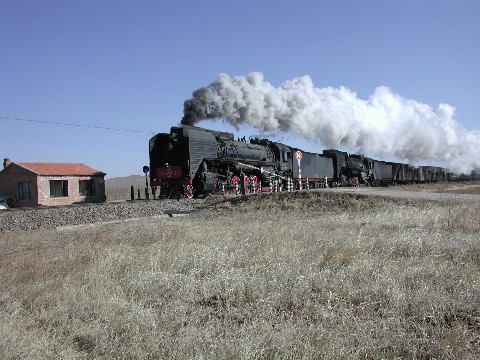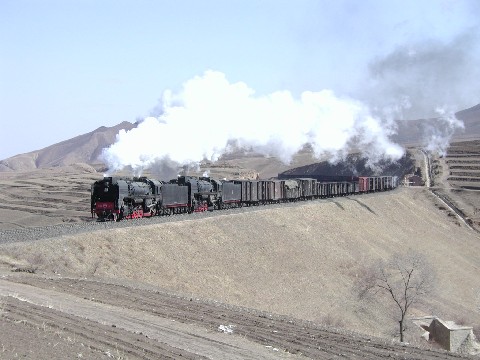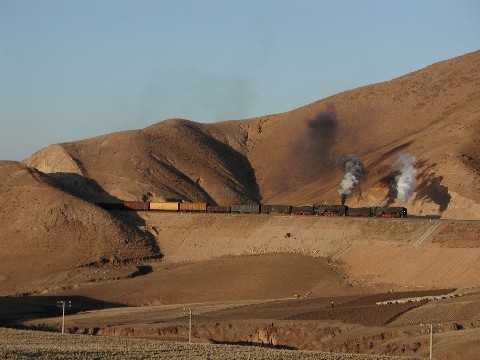 |
| QJ 6630 at a crossing near Linxi (Mar 26th 2002, © Martin Müller) |
 |
| QJ 6630 near Shidi (Mar 26th 2002, © Martin Müller) |
 |
| Near Liudigou (Mar 26th 2002, © Martin Müller) |
| www. SY-Country .co.uk |
Content | Welcome | News | Trip Reports | Steam Lines | Locomotive List | Travel Tips | Links |
The fourth day was spent east of Daban : the eb passenger, 1 eb and 3 wb freights between sunrise and 1 pm. Another eastbound train was scheduled at 3 pm.
The line has some photographic potential east of Gulumanhan (desert-like, mountains in the background). The gradient is against eastbound trains up to the level crossing of the road to Tongliao. In Gulumanhan heavy westbound trains are taking water, eastbound freights pass without stop. Trains have to work hard to accelerate their trains out of the station, heading towards Daban.
 |
| QJ 6630 at a crossing near Linxi (Mar 26th 2002, © Martin Müller) |
 |
| QJ 6630 near Shidi (Mar 26th 2002, © Martin Müller) |
 |
| Near Liudigou (Mar 26th 2002, © Martin Müller) |
JiTong employs about 8,000 people, out of them 1400 at Daban shed.
They own 6 diesels (=Baiqi`s DF4D). There are no plans to buy further diesels. They are going to run steam as long as it is permitted. The decision whether they will use steam or diesel is not made by JiTong management but will come from Beijing. They expect that they have to use diesel in two to four years.
Another major problem of the steam traction is that the repair shops for heavy overhauls will be closed one after each other. At the moment they are using Sujiatun workshop. But if you compare the facilities with Daban one`s you are wondering why they do not do heavy overhauls on their own.
A QJ gets an minor overhaul every 30,000 km, a intermediate overhaul every 70,000 km and a heavy overhaul after 100,000 km. The locos for Sujiatun run to Tongliao under steam. There CNR handles them
as a freight wagon for the rest of the journey. But sometimes, the CNR diesel loco driver ask the steam crew to support the diesel on steep gradients...
All facilities and the shed layout were originally designed for diesels. Therefore they will not have to invest a single Yuan in the infrastructure. The maintenance costs of one DF4 is similar to that of two QJs.
But the test runs Haoluku - Daban with DF4 produced an interesting result concerning the operating costs.
Fuel Costs
A QJ consumes 6 tons of coal for a trip to Haoluku and about 3.5 tons for the way back to Daban. So you need 19 tons of coal for a return trip with two QJs. One ton is 240 Yuan. Fuel costs for a round trip are 4,560 Yuan for a QJ double header.
A DF4 needs 2,800 litres diesel for Daban - Haoluku and 800 litres for Haoluku - Daban. A litre diesel is about 2.45 Yuan. So, a DF4 return trip will cost some 8,800 Yuan, 4260Yuan more than QJ+QJ train.
The costs for the second loco crew of a QJ+QJ train make little difference. A loco driver earns about 1,400 to 1,800 Yuan per month, firemen 900 to 1,400Y. One crew will have about 11 return trips per month. So the additional costs for the second crew amounts to some 360 Yuan per roundtrip. There are still some 4,000 Yuan additional profit left if you use steam instead of diesel.
Furthermore a double headed OJ-hauled train has a permitted maximum load of 2,300 tons, a single DF4 only 2,000 tons - 15 percent less...
But, unfortunately, all this does not count : steam is "old fashioned", diesel "modern" (although a DF4 isn't a modern diesel loco). By 2008 when the Olympic Games will take place in China, China will no longer have any steam locos. JiTong management expects that steam operation ends in 2004/5.
There are no plans to buy additional QJs from the CNR or other private railways. They still have some QJs for spare. Mainly they are used for spare parts for the running engines. Dumped in Daban we found : QJ 6577, 6735, 6795, 6844, 3073, 2645. Out of use were: QJ 2388, 2706, 6135.
Beside the mentioned we saw 35 locos, of which 32 were under steam:
QJ 6110, 6125, 6143, 6274, 6351, 6388, 6389, 6483, 6517, 6576, 6580, 6630, 6760, 6763 (under repair), 6828, 6840, 6878, 6911, 6978, 6981, 6986, 6997, 6998, 7009, 7010, 7012, 7037, 7040, 7041, 7063, 7112, 7137, 7143 and cold in the locoshed QJ 6230 and 6301.
The new branch line to Xilinhot is expect to be finished in August 2002. But they already expect a delay of the inauguration of about one or two months. It is similar to the inauguration of the JiTong line, they said.
Anshan now owns only 21 SY, it was said that all PL2 and YJ were scrapped. We found 17 locos in steam: SY 0131, 0306, 0428, 0433, 0436, 0440, 0571, 0833, 0836, 0902, 1035, 1036, 1038, 1505, 1555, 1566, 1588.
Many new second hand diesels appeared. We saw: DFH7 7008, 8001, 8003, GK1G 6001, 6002, 6003, 6006, 6008, 6009, 6010, 6027, 6029. No change amongst the different electrical locos and the GDR-V100 (NY17). No Chinese-built electrical locos were seen.
Nobody could say how long steam operation will last. The technical and external shape of the SY is still very good. Two locos were freshly painted for example.
No significant change compared with previous reports. Tiefa mine administration demands a photo permit for their lines and especially for the workshop and the stabling point. You can purchase the permit in
Daqing, were the mine railway administration is situated. They have a small "exhibition room" in Daqing, were some number plates, water glasses, whistles from SYs and a map of the system is shown. The price of the permit is not known because our guide bought them. We enjoyed a unguided and unhampered visit to the locoshed and even the workshop.
The workshop got an extension in a new building last November (Nov 2001). Now they are able to make heavy overhauls on their own. The workshop is very clean. Since November 2001, they had two heavy overhauls, a third was undergoing on SY 1767.
Asked in the beginning of our visit how long steam would survive they answered that there are already plans to introduce diesel engines. However, later they seemed to have changed their minds and said "no plans for dieselisation" but indicated a possible change from steam to electric transport. At least another two years with 100 % steam are expected.
In the workshop there is a list of all steamlocos (bold = seen under steam):
SY 0063, 0393, 0435, 0543, 0665, 0860, 0960, 0979, 1147, 1183, 1255, 1412, 1683, 1749, 1751, 1764, 1767, 1769, 1770, 1771, 1772
Borrowed were JS 5029. It was used for the steam festival they held last year. They will run another steam festival this year. Exact date was not known yet.
In the depot we found the out of use-SY 0023 together with another unidentifiable one.
Bernd Seiler, April 2002
| Content Page | Trip Report Page |
|---|